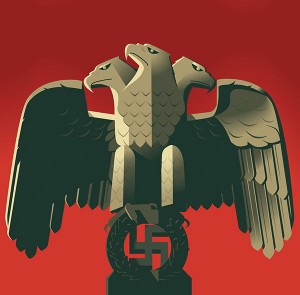 What made Germany lose the war? A lot of things. Inferior resources? Check. Numbers? Check. Adolf Hitler? Check. But one problem that doesn’t get enough attention is command structure. Hitler was at the top, but under him running the war on a daily basis was something called the High Command of the Armed Forces (abbreviated “OKW” in German). It was a joint command overseeing the army, navy, and air force. Jointness is all the rage these days in the Pentagon. No single service can win a war, so the theory goes, and only an organization that pays equal attention to land, sea, and air will get the job done.
What made Germany lose the war? A lot of things. Inferior resources? Check. Numbers? Check. Adolf Hitler? Check. But one problem that doesn’t get enough attention is command structure. Hitler was at the top, but under him running the war on a daily basis was something called the High Command of the Armed Forces (abbreviated “OKW” in German). It was a joint command overseeing the army, navy, and air force. Jointness is all the rage these days in the Pentagon. No single service can win a war, so the theory goes, and only an organization that pays equal attention to land, sea, and air will get the job done.
So far, so good—except for one problem. The German army was vastly larger than the other two services, larger than both put together. The Third Reich was a land power, and victory or defeat in the war was always going to be in the hands of the land force, with the air force playing a supporting role and the navy a distant third. Let’s face it: if you’re battling the Soviet army in the heart of Eurasia, naval operations are going to be peripheral.
In fact, Hitler had created the OKW back in 1938 not as a way to rationalize military planning, but to limit the influence of the army, whose officer corps he viewed as a decadent remnant of the old aristocracy, full of conservatives who would never support his radical designs. The German navy and air force understood their political role in the new command scheme and almost always formed a united front against the army in debates on resources, manpower, and operational planning.
For a nation supposedly so organized and orderly, the system that evolved was the height of inefficiency. By 1942, a de facto division of command had evolved. The High Command of the Army (the “OKH”) ran operations on the Eastern Front, where 80 percent of the German army was at any given time. The other fronts became “OKW theaters”—areas in which the army had to fight, but over which it had no jurisdiction. They included the Arctic, the Mediterranean, and the Western Front after the Allies landed there in 1944.
Slicing the war in two had enormous implications, none of them good. A single German division, for example, might be fighting in Russia (under OKH authority), then receive transfer orders to France (where it was under OKW control), and then be ordered back to Russia (again to the OKH). The result was a nightmare of competing jurisdictions and bureaucracies, which only a direct appeal to Hitler could solve. And as far as Hitler was concerned, that had been the point all along.
A great deal of folk wisdom has built up over the years about the necessity of having a single boss run a company—a “house divided,” for example, or “too many cooks.” The Germans fought World War II on two separate and competing organizational charts. Sure, Hitler was in charge, but the Führer’s command style only added to the problem. He liked to let the various services and agencies under him compete: for resources, for funding, for his approval. The more redundancy and competition, the more opportunity he had to step in and show that he was in charge. It’s difficult to imagine a more wasteful system, or one less suited to running a global war.
Sure, studying military bureaucracies isn’t a thrill a minute. That’s why they’re never going to make a movie called Administering Private Ryan. But a bureaucratic victory can be decisive, and flow charts and filing cabinets can be deadly weapons, as the Allies proved in World War II.✯
This excerpt was originally published in the November/December 2016 issue of World War II magazine. Subscribe here.





